5 Chapter 5
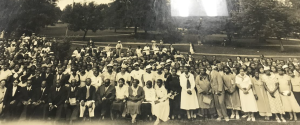
Whilst pastoring at Shiloh, in in 1937, Troy was asked to serve as a business manager at Oakwood Junior College in Huntsville, Alabama which operated under segregation. As one author explains, “Some of the students who had to deal with this practice were “driven” from the church”: they struggled to find employment within the church and were thus being forced to find work amongst other more accepting denominations, despite the SDA’s history of integration.
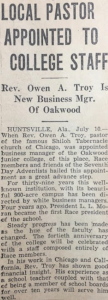
Segregated dining rooms, dormitories and staff at Emmanuel were challenged by Troy’s anti-segregationist stance, and the aid of his prominent brother-in-law Arna Bontemps. This endeavor was what first put Troy in contact with Director of The Associated Negro Press, Claude A. Barnett, who kept in contact with Dr. Troy on matters concerning the church and segregation throughout the following decades. Bontemps and Troy worked with prominent minsters and the Press to raise awareness of the situation in Michigan. For Bontemps, “segregation and kindred evils, even in so small a group as Seventh-day Adventists, should not be passed unnoticed.” Troy evidently felt just as impassioned: “It is extremely unfortunate that our youth have had to submit to the soul-embittering effects of prejudice and segregation” but was confident that the SDA World Conference in D.C. would correct the situation. Thanks to the advocacy of Troy, Bontemps and many others, the situation in Michigan reformed; in a letter to Barnett, Troy highlighted this progress: ‘Today [circa. 1945] that institution has nearly 30 colored students living in the dormitories and are well integrated in the entire life of the College. Last year one of the colored students was listed in “Who’s Who Among College Students.” This year a colored student from Chicago won first prize in an oratorical contest with 100 entrants.” Moreover, the World Conference of the SDA in Washington D.C., of which Troy was a delegate, remarked a new horizon for racial inclusion: a plan was launched for “an even closer integrated program than has been followed in the past,” which delegates suggested would include “the election of a Negro to an office such as vice president on the general conference level,” since this would “implement this racial constituency more closely into the organizational pattern of the denomination .”
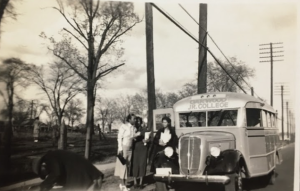
However, Emmanuel was not the only Seventh-day Adventist institution operating an underlying Jim Crow system, as Claude Barnett explained: “SDA is doing many good jobs but like America in general she needs to clean out her own stables”; whilst Troy and Bontemps had experienced the best of SDA integrated education at Pacific Union College in 1920s Los Angeles, Michigan was merely one example of the widespread issues of discrimination in other SDA colleges. Tied to the Emmanuel case was that of Oakwood Junior College in Huntsville Alabama, headed by J. L. Moran.
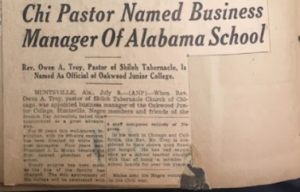
Troy’s appointment to the business staff at Oakwood Junior College in 1937 marked as “a great advance step” for the SDA institution because, as one report explained, “[f]or 39-years this well-known institution with its 900-acre campus has been directed by white business managers. Four years ago, President J. L. Moran became the first colored president of the school. … Steady progress has been made as the hue of the faculty has changed. The 40th anniversary of the college will be celebrated with a staff composed entirely of Negroes.”[1] However, like Emmanuel in Michigan, Oakwood was controlled by a false-fronted African American leadership backed by whites who favored segregation over the SDA’s new direction of integration. Moran, whilst being the first African American president, had recently dismissed the Emmanuel Missionary College’s controversy and implemented a similar kind of discrimination within his own institution. According to one report, Moran made an agreement with white Adventist college presidents to use his college as the preferred colored institution before allowing colored (African American) students to attend white colleges of the north. Under such an agreement, colored students, from both northern and southern states, would be barred from attending white, northern colleges unless they had first attended Oakwood College in Huntsville, Alabama. This, in essence, would segregate the youth in a “reported Jim Crow agreement” that threatened the churchwide integration of schooling. The controversy peaked in 1939 with an article entitled “Jim Crow in Michigan College Led to Betrayal by Uncle Tom” reporting segregated dining facilities at EMC and a wider conspiracy between SDA college presidents to defect African Americans. When The Associated Negro Press publicized such concerns, Moran, they reported, “laid aside his bible and threatened the Associated Negro Press if they did not divulge the name of the reporter who wrote the article disclosing his connection with a highly systematic plan to segregate the Negro youth of the Seventh-day Adventist denomination of which he is a member.”
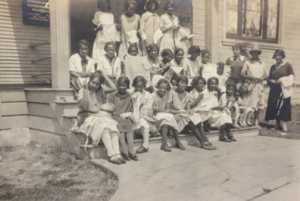
Troy joined the administration at Oakwood shortly after his brother-in-law Arna Wendell Bontemps had resigned his teaching position under pressure from the administration for his involvement in a student protest.[2] Believing him to hold too radical views, the distinguished poet and author, winner of the 1927 The Crisis poetry award for his “Nocturne at Bethesda,” claimed the administration demanded he burn his private books to demonstrate he had given up radical politics.[3] Refusing to do so, Bontemps returned to California in 1934, three years before Troy was to become the business manager of the school.
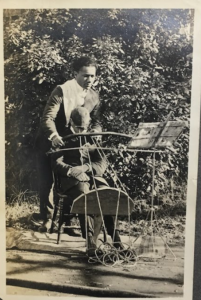
Music:
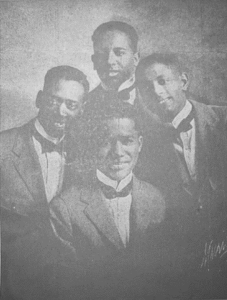
Both Owen and Ruby Troy had an enthusiasm for music, with Ruby as a talented pianist, and Owen Troy Sr. directing a choir at each of the churches he pastored. From his time at the Glee Club at Pacific Union College, to the evening musical performances that concluded each talk at the airdome in Chicago, Oakwood was no exception. Alongside his work as a business manager and efforts to overcome segregation in the Huntsville school, Troy also led the Alabama Singers. According to author Mervyn Warren, “[i]f there was any one thing more than any other that flavored the atmosphere of the [Oakwood] school it would have to be its music”; even today, the famed Aeolians represent the college at numerous international events each year.
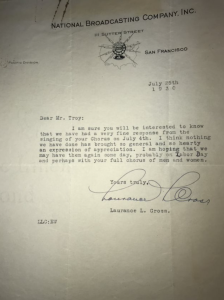
Eva B. Dykes, who originally organized the group in 1946, joined the college three years after Troy left for California.[4] However, even before the Aeolians, Oakwood was a vibrant center for music. Troy applied his passion for composing to the Alabama Singers group, writing a number of original songs relating to the history of the south and spiritual melodies.
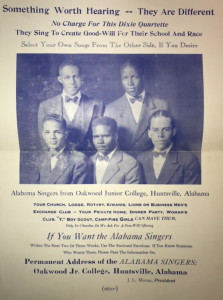
[1] Mervyn A. Warren, Oakwood! A Vision Splendid Continues (Collegedale, Tennessee, College Press: 2010).
[2] Protest known as the “Students Holiday of 1931.”
[3] The leadership were particularly concerned with a recent publication: “God Sent Sunday” and, according to the North American Regional Voice, burned the manuscript. Ibid. North American Regional Voice, December 1988: 5.
[4] “Who Was Eva B. Dykes?,” Eva B. Dykes Library Oakwood University, undated, https://library.oakwood.edu/index.php/aboutus/who-was-eva-b-dykes.

